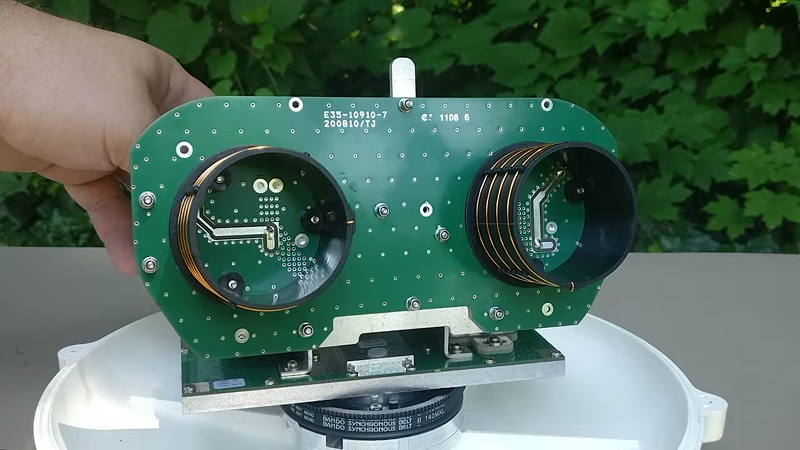[SignalsEverywhere] has a lot of satellite antennas and he’s willing to show them off — inside and out — in his latest video that you can see below. Using software-defined radio techniques, you can use these antennas to pull off weather satellite images and other space signals.
 A lot of these antennas are actually made for some commercial purpose like keeping ships connected to Inmarsat. In fact, the shipborne antenna has a nice motorized system for pointing the antenna that [SignalsEverywhere] is hoping to modify for his own purposes.
A lot of these antennas are actually made for some commercial purpose like keeping ships connected to Inmarsat. In fact, the shipborne antenna has a nice motorized system for pointing the antenna that [SignalsEverywhere] is hoping to modify for his own purposes.
With what appears to be standard NEMA 17 steppers onboard, it should be relatively easy to supplant the original controller with an Arduino and CNC shield. Though considering the resale value these particular units seem to have on eBay, we might be inclined to just roll our own positioner.
The QHF QFH antenna is another interesting teardown. The antenna makes a helix shape and looks like it would be interesting to build from scratch. There isn’t a lot of details about the antenna designs, but it is interesting to see the variety and range of antennas and how they appear internally.
L band is from 1 GHz to 2 GHz, so signals and antennas get very strange at these frequencies. The wavelength of a 2GHz signal is only 15cm, so small antennas can work quite well and are often as much mechanical designs as electrical. The L band contains everything from GPS to phone calls to ADS-B.
We’ve seen radiosonde antennas reborn before. Dish antenna repurposing is also popular.
















Old satcom nerd here…~10yrs as a 31S/25S in the army. Making a great satcom antenna shouldn’t be that difficult to do, even one with auto-tracking capabilities. I frequently come across old satellite TV gear that is headed for the dump, all of which would be ideal for this application. All you really have to do is make sure that your LNA and feed horn are in the correct freq range. EBay usually has a ton of them available if you need to change them.
Because the dish is small and light, a gimbaled mount could be 3d printed. After that its just a matter of stepper motors and threaded rod.
QFH = Quadri-filar helix
QHF = ???
And not every helical is quadrfilar.
QHF could stand for Quasi High Frequency. As in the 160M band, though that’s the opposite direction of where we’re going. Probably the best propagation these days though. 73!
qhf quadrafilar helix antenna …not 160
Here’s a picture. https://www.jcoppens.com/ant/qfh/index.en.php
You can see that they are quadrifilar because they have four windings/elements wound on the same centre.
The ones in your heading picture don’t look quadrifilar
The one in the header are helicals, if you watch the video there was a GPS QFH antenna that I use for iridium.
I was wondering which device this was, but since the video is gone, I did some digging. Looks like its a Globe Wireless i250 Dome Antenna. Found them on ebay but they are not cheap. As of 12/14/23 they are about $1k